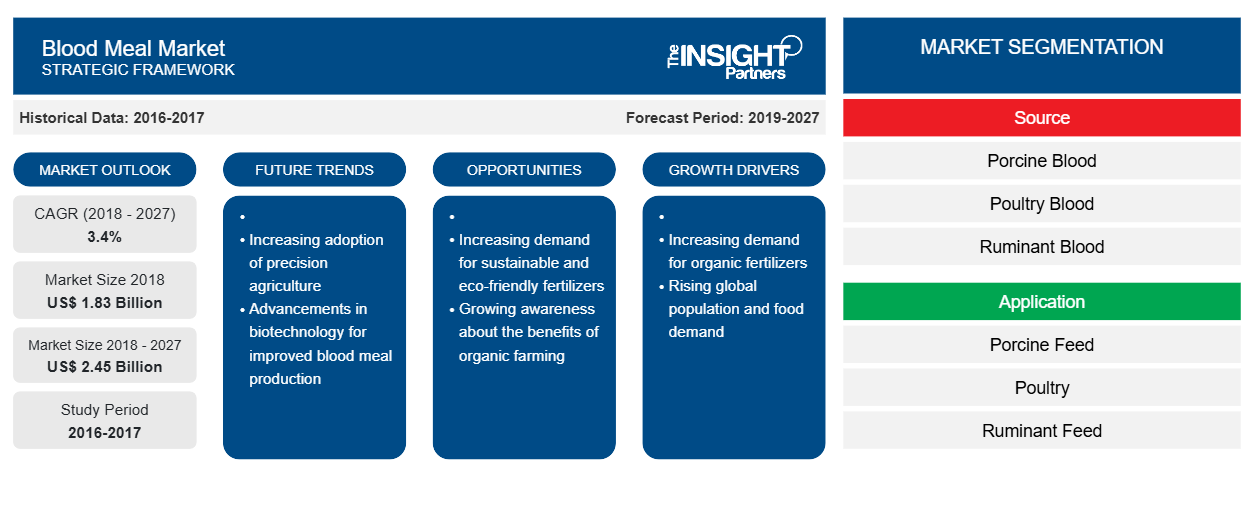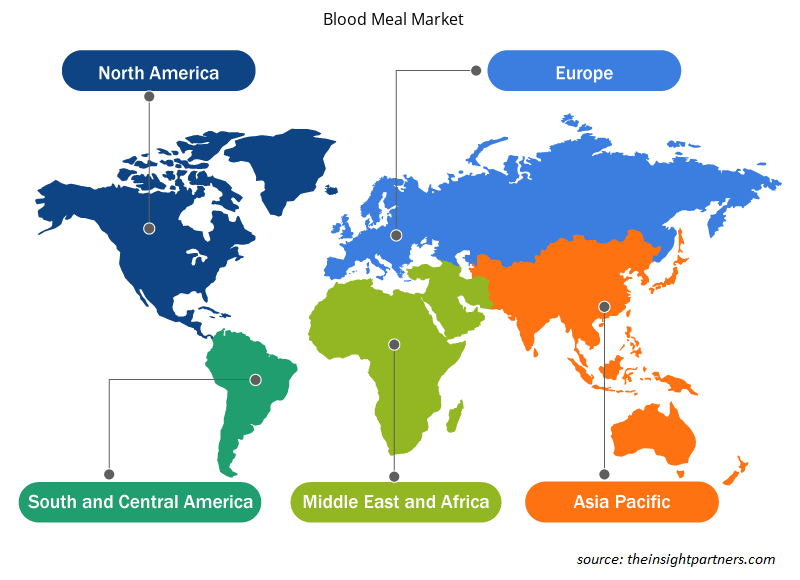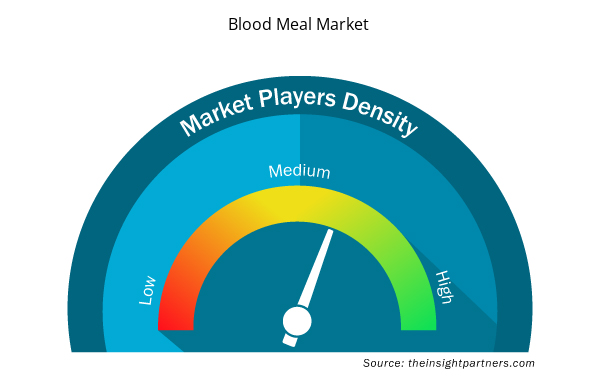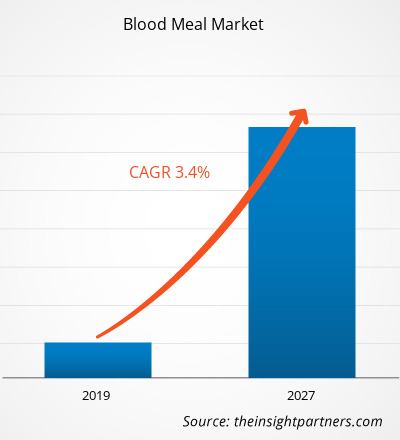The blood meal market was valued at US$ 1,825.9 million in 2018 and is expected to reach US$2,451.6 million by 2027; it is projected to grow at a CAGR of 3.4%from 2019 to 2027.
A blood meal is a dried & inert powder prepared from the blood of different livestock, including cattle, pigs, and chickens, under very specific conditions. It is utilized as a high nitrogen organic fertilizer and as a high protein feed for animals. It is considered one of the highest non synthetic sources of nitrogen. A blood meal is used as a dietary supplement for livestock, and it is mainly included in supplying dietary lysine for livestock. Bone meal, blood meal, and other animal by-products are authorized in certified organic production, mainly as soil amendments. A blood meal is another bone meal; however, blood meal carries a higher amount of nitrogen, while a bone meal holds phosphorus. A blood meal is further used as a composting activator. Blood meal can also be spread over gardens to deter pest animals like rabbits.
The blood meal market in the North American region is expected to grow at the highest CAGR of 4.1% during the forecast period. The growth of the livestock industry plays a most crucial role in meeting the growing demand for food. And blood meal is highly utilized in the animal feed industry in terms of aquafeed, ruminant feed, and poultry feed. The production, as well as consumption of blood meal, is further increasing in the US owing to increasing demand for healthy food options coupled with a rising focus regarding organic product among the population. The increase in disposable per capita income of consumers has further motivated them to look forward to even healthy feed ingredients, which are presumed to boost the growth of the market. Most of the manufacturers are also taking advantages of utilizing less costly ingredient like blood meal in animal feed.
Customize This Report To Suit Your Requirement
You will get customization on any report - free of charge - including parts of this report, or country-level analysis, Excel Data pack, as well as avail great offers and discounts for start-ups & universities
Blood Meal Market: Strategic Insights

- Get Top Key Market Trends of this report.This FREE sample will include data analysis, ranging from market trends to estimates and forecasts.
Customize This Report To Suit Your Requirement
You will get customization on any report - free of charge - including parts of this report, or country-level analysis, Excel Data pack, as well as avail great offers and discounts for start-ups & universities
Blood Meal Market: Strategic Insights

- Get Top Key Market Trends of this report.This FREE sample will include data analysis, ranging from market trends to estimates and forecasts.
Effect of COVID-19 Upon Blood Meal Market
The recent COVID-19outbreak began in Wuhan (China) in December 2019, and since then, it has spread at a fast pace across all regions in the world. As of May 2020, the US, India, Brazil, Russia, Spain, the UK, and some other countries are among the worst-hit countries in terms of confirmed cases and reported deaths. The outbreak has been affecting economies in various countries due to lockdowns, travel bans, and business shutdowns called protective measures to stop the spread of COVID-19. The food processing industry is considered as one of the major industries in the world that are suffering serious factory shutdown, supply chain disruptions, technology events cancellations, and office shutdowns because of this outbreak. Even though some of the manufacturers are trying to recover their loss by implementing new strategies, it will take ample time to overcome the pandemic loss.
Market Insights
Growing Demand for Nutritional Feed
Blood is used as a liquid protein due to its high protein content, and it is rich in amino acids such as Lysine. It has a benefit over plant-based protein, which holds low lysine content. Some of the factors that are influencing the growth of the blood meal market include the rise in disposable per capita incomes of people, high living standards, growing demand for animal proteins, and tend to prefer organic products. In addition, the growth in aquaculture is also creating the demand for nutritious feed. There is also an increasing demand for meat products and an increase in the slaughter of animals, further opening up various opportunities for producers of the blood meal. The ongoing ‘organic trend also proven to be a positive factor for this market. Farmers used blood meal as natural fertilizer since it contains nitrogen. The multiple benefits possess by blood meal are anticipated to boost market growth throughout the forecast period.
Source-Based Insights
The blood meal market, based on source, is segmented into porcine blood, poultry blood, and ruminant blood. The poultry blood segment accounted for the largest share of the market in 2018, and the market for the porcine blood segment is expected to grow at the highest CAGR during the forecast period. Poultry blood is the commonly preferred raw material, which is utilized to produce blood meal owing to its high amino acid content, especially Lysine. A poultry Blood meal is a natural source of protein, which is employed as an ingredient in animal feed, mainly for pigs, poultry, fish, and other species which are non-ruminant. The raw material is basically collected from slaughterhouses, and it is processed in a poultry processing plant. The blood meal is free from the additives that improve the natural protein.
Application-Based Insights
The blood meal market, based on application, is segmented into porcine feed, poultry feed, ruminant feed, aquafeed, and others. The porcine feed segment accounted for the largest share of the market in 2018, whereas the aqua feed segment is expected to register the highest CAGR during the forecast period. Spray-dried porcine plasma is prepared by processes such as the blood from slaughtered pigs is collected and added to an anticoagulant, which is generally sodium citrate, then it is centrifuged to remove erythrocytes. The plasma collected is consequently spray-dried and utilized to produce animal feeds.
Process-Based Insights
The blood meal market, based on process, is segmented into solar drying, drum drying, ring and flash drying, and spray drying. The ring and flash drying segment accounted for the largest share of the market in 2018, whereas the solar drying segment is expected to register the fastest CAGR during the forecast period. The blood is first dispersed into a high-velocity venturi section of the system. The blood at first attends the hot drying airstream, and then the evaporation occurs. The product is further dried as soon as it is conveyed up via the drying column. The presence of an internal classifier in the ring drying system mainly differentiates it from the flash dryer. Ring drying includes coagulating the blood through steam heating; the coagulum is centrifuged & dried with hot gas in a ring drier. The ring-dried blood meal offers greater content of a total volume, and the presence of amino acids is of better nutritional quality. For instance, lysine availability as a percentage is 84% to 89% for a ring-dried blood meal, than to batch-dried blood meal in which lysine is just 62% to 77%.
Mergers and acquisitions, and research and development are the commonly adopted strategies by companies to expand their footprints worldwide, which is further impacting the size of the market. The players present in the blood mealmarket such Ridley Corporation Limited have been implementing the abovementioned strategies to expand their customer base and gain significant share in the global market, which also enables them to maintain their brand name globally.
Blood Meal Market Regional Insights
The regional trends and factors influencing the Blood Meal Market throughout the forecast period have been thoroughly explained by the analysts at Insight Partners. This section also discusses Blood Meal Market segments and geography across North America, Europe, Asia Pacific, Middle East and Africa, and South and Central America.

- Get the Regional Specific Data for Blood Meal Market
Blood Meal Market Report Scope
| Report Attribute | Details |
|---|---|
| Market size in 2018 | US$ 1.83 Billion |
| Market Size by 2027 | US$ 2.45 Billion |
| Global CAGR (2018 - 2027) | 3.4% |
| Historical Data | 2016-2017 |
| Forecast period | 2019-2027 |
| Segments Covered |
By Source
|
| Regions and Countries Covered | North America
|
| Market leaders and key company profiles |
Blood Meal Market Players Density: Understanding Its Impact on Business Dynamics
The Blood Meal Market market is growing rapidly, driven by increasing end-user demand due to factors such as evolving consumer preferences, technological advancements, and greater awareness of the product's benefits. As demand rises, businesses are expanding their offerings, innovating to meet consumer needs, and capitalizing on emerging trends, which further fuels market growth.
Market players density refers to the distribution of firms or companies operating within a particular market or industry. It indicates how many competitors (market players) are present in a given market space relative to its size or total market value.
Major Companies operating in the Blood Meal Market are:
- Allanasonsn Pvt Ltd
- APC Company, Inc.
- Apelsa Guadalajara, SA de CV
- DAR PRO Ingredients
- Ridley Corporation Limited
Disclaimer: The companies listed above are not ranked in any particular order.

- Get the Blood Meal Market top key players overview
Report Spotlights
- Progressive industry trends in the global blood mealmarket to help players develop effective long-term strategies
- Business growth strategies adopted by companies in developed and developing markets
- Quantitative analysis of the global blood meal market from 2017 to 2027
- Estimation of global blood meal demand generated by various industries
- PEST analysis to illustrate the efficacy of buyers and suppliers operating in the blood meal ecosystem
- Recent developments to understand the competitive market scenario and global blood mealdemand
- Market trends and outlook, coupled with factors driving and restraining the growth of the global blood meal market
- Insights to help in decision-making process by understanding strategies which underpin commercial interest with regard to the blood meal market growth globally
- Global blood meal market size at various nodes of the market
- Detailed overview and segmentation of the global blood meal market, as well as the blood meal industry dynamics
- Global blood meal market size in various regions with promising growth opportunities
Blood Meal Market – By Source
- Porcine Blood
- Poultry Blood
- Ruminant Blood
Blood Meal Market – By Application
- Porcine Feed
- Poulty Feed
- Ruminant Feed
- Aqua Feed
- Others
Blood Meal Market – By Process
- Solar Drying
- Drum Drying
- Ring and Flash Drying
- Spray Drying
Company Profiles
- Allanasons Pvt Ltd
- APC Company, Inc.,
- Apelsa Guadalajara, SA de CV
- DAR PRO Ingredients
- Ridley Corporation Limited
- Sanimax
- TerramarChile
- The Boyer Valley Company, Inc.
- Valley Proteins, Inc.
- FASA Group
- Historical Analysis (2 Years), Base Year, Forecast (7 Years) with CAGR
- PEST and SWOT Analysis
- Market Size Value / Volume - Global, Regional, Country
- Industry and Competitive Landscape
- Excel Dataset



Report Coverage
Revenue forecast, Company Analysis, Industry landscape, Growth factors, and Trends

Segment Covered
Source ; Application ; Process ; and Geography

Regional Scope
North America, Europe, Asia Pacific, Middle East & Africa, South & Central America

Country Scope
Argentina, Australia, Brazil, Canada, China, France, Germany, India, Italy, Japan, Mexico, Russian Federation, Saudi Arabia, South Africa, South Korea, United Arab Emirates, United Kingdom, United States
Frequently Asked Questions
Ans.Among all three segments of source, the poultry blood segment has led the market in 2018 and is expected to be the dominant segment in the near future.Poultry blood is collected from chicken mainly for two purposes, such as to obtain serum, which can be tested for various disease virus antibodies, no anticoagulant is required in this process, and the blood is allowed to clot. The levels of antibody detected in individual birds and flocks give an indication of the response to vaccination. It also indicates whether birds have been challenged by field strains of any disease virus. Secondly, to obtain red blood cells, the blood is collected into anticoagulant. These can be further used in preparing blood meal. A blood meal is produced from poultry by-products as a high-protein component in animal feeds. The minimum protein content found in poultry blood meal is 80%. A poultry Blood meal is one of the natural sources of protein, which is used as an ingredient animal feed for swine, poultry, fish, and other non-ruminant species. Poultry blood is on-demand from the pet food manufacturing industry due to an increase in demand for more pet food.
The major players operating in the global blood meal market are Allanasons Pvt Ltd, APC Company, Inc., Apelsa Guadalajara, SA de CV, DAR PRO Ingredients, Ridley Corporation Limited, Sanimax, Terramar Chile, The Boyer Valley Company, Inc., Valley Proteins, Inc., FASA Group, and among many others.
In 2018, the blood mealmarket was predominantbyAsia-Pacific at theglobal level.Asia-pacific is the largest continent in the world and is known for its organic agriculture and feed products. Asia has ranked highest amongst feed producing regions. China is dominating the regional market, followed by other countries such as Japan, India, Vietnam, Korea, Thailand, Malaysia, and Indonesia. These countries are witnessing rising demand for poultry, egg, and meat products. Apart from its utility in the feed industry, blood meal is extensively utilized as an organic fertilizer to promote the growth of crops and to control pests. The growing consciousness among consumers for a healthy lifestyle has posed a demand for healthy animal-derived products, which is expected to boost the demand for blood meal in global market.
Trends and growth analysis reports related to Food and Beverages : READ MORE..
The List of Companies - Blood Meal Market
- Allanasonsn Pvt Ltd
- APC Company, Inc.
- Apelsa Guadalajara, SA de CV
- DAR PRO Ingredients
- Ridley Corporation Limited
- Sanimax
- Terramar Chile SpA
- The Boyer Valley Company, Inc
- Valley Proteins, Inc.
- FASA Group

 Get Free Sample For
Get Free Sample For